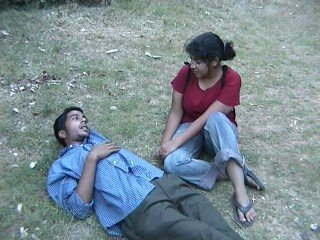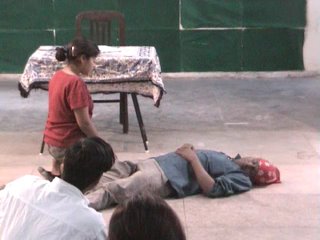
Shiva and Neha Mishra

Sharan and Neha Mishra




This blog is a place for me to scribble down my thoughts on the movies I have watched. Consider this as a dialogue zone and contribute your thoughts to it.

No Motive... (Col/English-Hindi/43 min/India/2005) Dir: RG This film was made as part of a M.Phil. (Master of Philosophy) course on "Popular Culture." The central theme of the film is 'death and the Other.' The fulfilment of |
| I was reading a conversation between Jean Luc-Nancy and Kiarostami... |
| If you're familiar with Kiarostami films, you'll find the following text more meaningful. |
On extreme introspective moments I used to recall a dialogue from Kiarostami's Close Up where the person who was caught, trialed and later acquitted by court for impersonating the famous film maker, Makhmalbaf, says, 'Now I understand everything.' I used to compare this piece of dialogue with the last few words of Pierre, the protagonist in Godard's, Pierre goes wild. Pierre prepares himself for suicide after murdering his lover in a fit of rage about her unfaithful behavior. Before he ties the dynamite round his head he says as if giving explanation to the whole act, 'what i am trying to say is that'. In a few moments we see just a globe of fire and Pierre becomes ashes.
For me the second dialogue is more appealing; bereft of any meaning for events even on the face of death. |
 | L’Italia è famosa per il cinema. In questo paese ci sono stati molti registi che hanno fatto molti film classici. Il mio progetto di viaggio in Italia comprende cinque-sei luoghi che sono i più importanti per il cinema Mondiale. Io comincerei il mio viaggio da Torino che si trova nel nord-ovest dell’Italia. |
| È la capitale di Piemonte, regione dell’Italia e si trova vicino alle Alpi. Andrei a Torino, in via Montebello per visitare la Mole Antonelliana, dove ci sono i tresori del cinema. Sono sicuro che la veduta sarà meravigliosa. La Mole Antonelliana, che è alta 167,5 metri è l’edifico di mattoni più alto in Europa. Questa struttura di diciannovesimo secolo è il monumento simbolo della città di Torino. Alessandro Antonelli l’ha costruita nel 1863 per la comunita Ebraica ed era originariamente una sinagoga. Vorrei visitare due luoghi in particolare: il Museo Nazionale del Cinema e il Cinema Massimo. Nel Museo Nazionale del Cinema ci sono diversi settori: l'Archeologia del Cinema, la Macchina del Cinema, la Collezione dei Manifesti, le Video installazioni e la grande Aula del Tempio. Il Museo ha lanterne magiche, scatole ottiche, fotografie, disegni, bozzetti e molti altri oggetti curiosi. Forse è il museo del cinema più bello, più ricco e più vivo del mondo, sia per la ricchezza del materiale, sia per il luogo. Nel Museo del Cinema scoprirò come è il nato il movimento fotografia e le origini del cinema. Cinema Massimo è famoso perche ha tre grandi sale di proiezione La Suola Nazionale del Cinema, Torino Quando ero bambino volevo fare una professione nel cinema. Perciò il questo argomento mi ha sempre attirato. Visiterò sicuramente la Scuola Nazionale del Cinema. È, insieme a quella di Leningrado, la prima scuola di cinema del mondo. Da Antonioni alla Cavani, da Bellocchio a Virzì, da Loy all’Archibugi, da Maselli a Verdone, molti registi famosi sono passati per questa scuola del Centro Sperimentale di Cinematografia. Vorrei anche visitare la biblioteca d’istituto: la Biblioteca Luigi Chiarini, che è la maggior biblioteca italiana specializzata nel settore. Vorrei anche visitare la Biblioteca Internazionale Di Cinema E Fotografia Mario Gromo a Torino che ha le collezione speciale di tanti fotografi. Torino è famosa anche per altre cose. Torino è stata la prima capitale d’Italia. Dopo la mia visita nei posti piu importanti per il cinema, a Torino vorrei visitare il Museo Egizio. È il secondo museo piu grande del mondo per l’arte Egizia. Trovero sicuramente tempo per visitare i Palazzi Reali a Torino. Spero di poter vedere Stupinigi, Racconigi, e il Palazzo Reale in un giornata. Per tutto il tempo del mio viaggio a Torino mangero i cioccolatini di Peyrono, di Ferroro e andro al caffe “Bicerin”, famoso per il suo caffe al cioccolato. E i miei amici mi hanno già detto di portare loro qualche cioccolatino. Alla fine, visitero un posto molto importante per la mia religione. A Torino ogni cristiano deve visitare la Sindone. La leggenda dice che era il lenzvolo in cui e stato avvolto Gesù nel momento della sua morte. Sara una esperienza unica vedere l’immagine della faccia di Gesù che e stampata sul lenzvolo. E un miracolo senza spiegazione. Cinecittà (Roma) La Città del cinema è situata a sud-est di Roma, Cinecittà offre tutto cio è necessario per fare il film: i teatri, i servizii tecnici, un scuola di cinematografia ecc. Fu costruita nel 1937 ed e diventata un luogo per lo scambio culturale. Sarebbe una esperienza meravigliosa per me se potersi andare dove molti registi famosi, per esempio, Federico Fellini, Roberto Rossellini ecc. hanno fatto i loro film. Ho visto un film sui gladiatori: “Gladiator”. Il loro coraggio e la loro forza sono incredibili. Per questo voglio vedere il Colosseo. È un luogo dove c’erano spettacoli di sangue in epoca Romana. Non mi perdero certo i musei Vaticani a Roma, in particolare la Cappella Sistina. È una meravigliosa opera d’arte di Michel Angelo. Reciterei la mie preghiere nella Cappella Sistina. Visiterò anche San Pietro. “La Dolce Vita” è stato un film che esprima la filosofia degli italiani verso la vita. Nonostante tutte le tristezze e I problemi, a loro piace molto la vita. Vorrei andare alla Fontana di Trevi che è il luogo indimenticabile delle “La Dolce Vita”. Anche vorrei vedere Via Veneto dove la sera incontravano gli artisti del cinema. E dopo vorrei girare per Piazza Spogne o Trinite dei Marti. A Roma, anche visitero il Museo Nazionale del cinema e della Spettacolo. E un museo piccolo che contene le attrezzatture per fare il film, I costumi, e altri oggetti. Io andrò sicuramente nelle tre biblioteche splendide che sono lì – la biblioteca dei film, della fotografia e delle video cassette. Questo sarà il mio viaggio nel cinema italiano. |
 | ‘Seeing is believing’, the saying might be true a few decades ago. Today when images everywhere have become mere ‘visual commodities’, one can easily doubt the truthfulness of them. It’s true that we have |
| infront of us a whole range of images in various media especially the television, films and the internet. These images range from news to entertainment, from costumes to automobiles. But even as we are bombarded with images to our right and left, few of us reflect upon their quality. We are in the habit of taking whatever is offered to us. Debates about the quality of any form of human expression certainly are never ending. But one cannot miss out the process of mutual reinforcement between society and media: society (read it ‘popular culture’) loves sensationalism, melodrama and those superficial treatments of all human emotions; be it news stories, literature or films. Whereas on the other hand, society is satisfied with them because these are the only tales usually told. I would be interested to say something about the need to develop a better visual culture among school children. However, the topic is also equally relevant for other sections of our society. Considering the pathetic quality of films (be it Bollywood or Hollywood) and television programmes children usually see, anyone concerned about child development will be of the opinion that something better should be shown to them. However, contrary to what many of us think, research in mass communication has proved that mass media do not have direct effects on humans. But, as far as training of children is concerned, one has to have a pragmatic approach where the question is to base oneself at some point. Thus the ultimate task would be, as I have mentioned earlier, two-faced; first, to produce quality films and programmes which however is beyond the powers of children for the most part. And the second is to develop a good viewing culture among children themselves. As for achieving the latter, our academic curriculum, various student activities, the school atmosphere etc. can help a lot. While students are familiar with many pioneer poets and writers of our country, they hardly know those film-makers like Satyajit Ray or Adoor Goplakrishnan who have helped Indian films to find a place in the world cinema map. Nor our children have a historical knowledge of cinema; the milestones in its path, the struggles it had successfully fought. At least a brief history of this form of human expression has to be included in the academic curriculum. Introducing students with some classic world movies can be another step. A conscious effort is necessary in this regard. Language is a barrier. But, nowadays most foreign films carry subtitles in English. With necessary training we can help our children enjoy good foreign language movies other than English. Finally, organizing photographic exhibitions in schools, training students to visualize different themes, helping them make short films even with the help of some low profile equipment; all these can be planned at school level. It will enable them to reflect upon various societal issues of their time with the help of this powerful tool called photography. Nevertheless, such endeavors also help them to defend themselves against the invasion of those images from the First World. The article was written in September 2003, when I was working as an Activity Teacher for Photography in one of the public schools in New Delhi. |